
-
Find the right food for your pet
Take this quiz to see which food may be the best for your furry friend.
Find the right food for your pet
Take this quiz to see which food may be the best for your furry friend.
Featured products
 Adult Healthy Cuisine Roasted Chicken, Carrots & Spinach Stew Dog Food
Adult Healthy Cuisine Roasted Chicken, Carrots & Spinach Stew Dog FoodDelicious roasted chicken paired with tender vegetables in a succulent stew
Shop Now Adult 7+ Perfect Digestion Chicken, Whole Oats & Brown Rice Recipe Dog Food
Adult 7+ Perfect Digestion Chicken, Whole Oats & Brown Rice Recipe Dog FoodScience Diet's breakthrough nutrition supports ultimate digestive well-being & healthy microbiome for dogs age 7+
Shop Now Small & Mini Savory Stew with Chicken & Vegetables Dog Food
Small & Mini Savory Stew with Chicken & Vegetables Dog FoodA delicious complement to the nutrition of Science Diet Small & Mini 7+ dog food
Shop NowFeatured products
 Adult 7+ Tender Tuna Dinner Cat Food
Adult 7+ Tender Tuna Dinner Cat FoodWith delicious chunks in a decadent gravy
Shop Now Adult Savory Entrée Can Variety Pack Cat Food
Adult Savory Entrée Can Variety Pack Cat FoodPrecisely balanced nutrition with the delicious taste of savory minced chicken to help fuel the energy needs of cats during the prime of their life
Shop Now Adult 7+ Senior Vitality Chicken & Vegetable Stew Cat Food
Adult 7+ Senior Vitality Chicken & Vegetable Stew Cat FoodImproves Everyday Ability to Get Up & Go
Shop Now -
Dog
- Dog Tips & Articles
-
Health Category
- Weight
- Food & Environmental Sensitivities
- Urinary
- Digestive
- Joint
- Kidney
-
Life Stage
- Puppy Nutrition
- Adult Nutrition
- Senior Nutrition
Cat
- Cat Tips & Articles
-
Health Category
- Weight
- Skin & Food Sensitivities
- Urinary
- Digestive
- Kidney
-
Life Stage
- Kitten Nutrition
- Adult Nutrition
Featured articles
 Why Are Dogs and Cats So Cute?
Why Are Dogs and Cats So Cute?If waggy puppy dog tails and furry kitten yawns make you swoon, you're not alone. Why are cats so cute? And, dogs too! Let's find out!
Read More Does My Pet Hate Me?
Does My Pet Hate Me?Learn tips for bonding with your pet if you've ever thought, 'My dog doesn't like me, or 'Why do I have a standoffish cat?'
Read More Do Dogs and Cats have Belly Buttons?
Do Dogs and Cats have Belly Buttons?Learn whether cats & dogs have belly buttons like humans, what the function is, and if there are any health concerns associated with it.
Read More -


If you'd like to take your cat for a stroll around your neighborhood, then it may be time to invest in a cat walking harness. But getting a harness for your feline friend is just the first step. Next, you need to figure out how to put on a cat harness.
Keep reading for tips on choosing a cat harness and getting your kitty comfortable wearing one.
Why Use a Cat Harness?
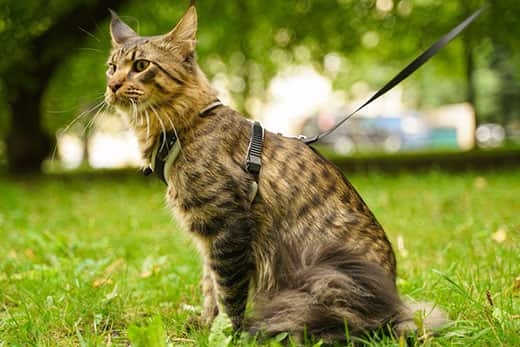
Walking your cat outdoors is a great way to provide them with mental and physical stimulation. But before your cat explores the great outdoors, it's important to get them a secure harness.
Using a harness is more secure than a collar and leash, according to Trupanion, because "[there's] no way for a cat to slide out of a harness," while cats can slither out of a collar in no time. And if a cat is too squirmy, a collar and leash could potentially injure their throat.
Cat Walking Harnesses
There are three main cat harness styles, all of which will keep your kitty secure. Once you decide on the best style for your pet, you can choose one in a fun color or pattern. Be sure to go with one that's made out of a soft material, so it will be comfortable for your kitty.
H-Style Harness
This harness has three main straps: one that goes around a cat's neck, one that goes around their waist and one that connects these two straps under their belly and/or back. This harness's double loops make it difficult for a cat to wiggle out, and the buckles are easy to adjust.
Figure-8 Harness
Like the H-style harness, a figure-eight cat harness has two loops. One loop goes around a cat's neck like a collar, and the other goes around their waist. This design gives your cat freedom of movement and is very difficult to shimmy out of.
Vest Harness
The vest harness is supportive and comfortable. Depending on the brand and design, the vest will either fasten across your cat's back or their underbelly. Either way, your cat won't be able to slip out of it.


Tasty Tips
How to Put on a Cat Harness
Putting a harness on a cat isn't easy, especially if your kitty is feisty. This is why the American Association of Feline Practitioners recommends acclimating your cat to a harness while they're still a kitten. But if you have an adult cat, don't worry — it's never too late to get your cat used to a harness, especially if they tend to be open to new experiences. Keep reading on how to get your cat used to a harness.
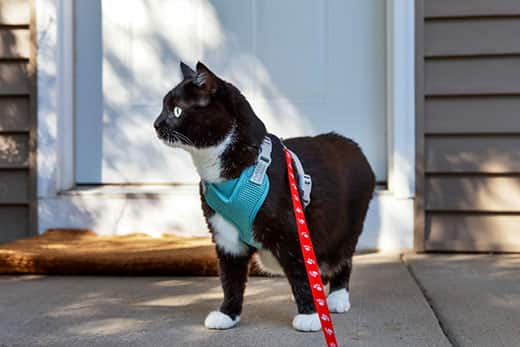
Steps for Suiting Up
To prepare, read the directions that come with the harness you have. Your cat will be fidgety at first, so plan in advance steps you can take to make them feel more comfortable.
Follow these steps to put on your cat's walking harness:
- Leave out the harness so your cat can inspect it. Placing it somewhere familiar, such as their favorite napping or feeding spot, can help take away their fear of the new object.
- When you feel your cat is ready, slip the harness over their head.
- If the harness is an H-style or a figure-eight style, fasten the neck straps, then secure the midsection strap and the back strap, if there is one. If you have a vest harness, place it on your cat's back, then fasten the neck and midsection clips.
- Try practicing walking on the harness in the home first. Let them get used to it as part of their natural habitat.
The first time you try putting the harness on your cat, it might be helpful to have some help. While one person holds your cat, you can help place the harness on them. If your cat doesn't like this and tries to wriggle free or scratches and bites at you, this is probably a good sign they're not into the idea. The last thing you want to do is stress out your cat, as it can create other problems in their life, like urinating outside the litter box. The last thing you want do is make them stressful before they go on an outdoor adventure.
The Royal Society for the Prevention of Cruelty to Animals Queensland advises using a reward system, such as having harness practice right before dinnertime, so your kitty learns to associate the harness with a yummy meal.
Proper Fit
Your cat should be snug in their harness and unable to get out of it on their own, but should still be able to fully move their head and legs. "You should only be able to get 1-2 fingers underneath" a properly fitting collar, explains International Cat Care. They also note that cats may tense their muscles when first trying on a collar, so always recheck the fit before going outside. When in doubt, contact your veterinarian for advice.
As with any type of cat training, getting your cat used to a cat harness takes patience and time. The reward? You get to stroll outside with your best furry friend, knowing they're safe and secure.


Christine O'Brien is a writer, mom, and long-time cat parent whose two Russian Blues rule the house. Her work also appears in Care.com, What to Expect, and Fit Pregnancy, where she writes about pets, pregnancy, and family life. Find and follow her on Instagram and Twitter @brovelliobrien.
Related products
Related articles
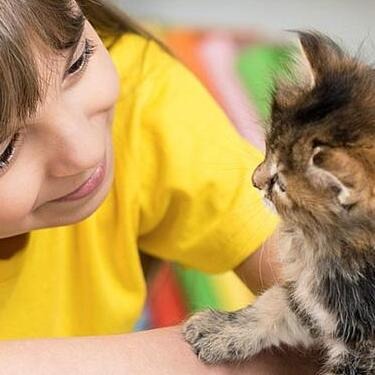
Discover how to train your cat, starting with very basic first steps that both reward good behavior and discourage the bad.
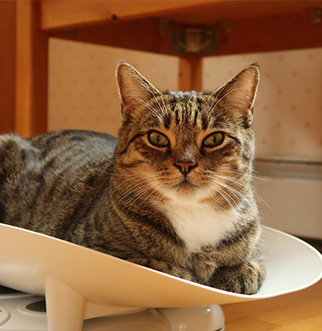
How do you get a cat to lose weight? Learn all about cat foods for weight loss, including how to choose weight control cat food and exercise tips.

What is the best food for an overweight cat? Learn all about weight control food for cats, including what's in it and how it works.
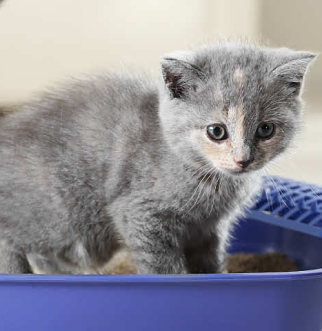
Cats are naturally very clean and chances are your kitten will already have learned how to use the litter box from her mother before she comes to live with you.

Put your cat on a diet without them knowing
Our low calorie formula helps you control your cat's weight. It's packed with high-quality protein for building lean muscles, and made with purposeful ingredients for a flavorful, nutritious meal. Clinically proven antioxidants, Vitamin C+E, help promote a healthy immune system.
Put your cat on a diet without them knowing
Our low calorie formula helps you control your cat's weight. It's packed with high-quality protein for building lean muscles, and made with purposeful ingredients for a flavorful, nutritious meal. Clinically proven antioxidants, Vitamin C+E, help promote a healthy immune system.

